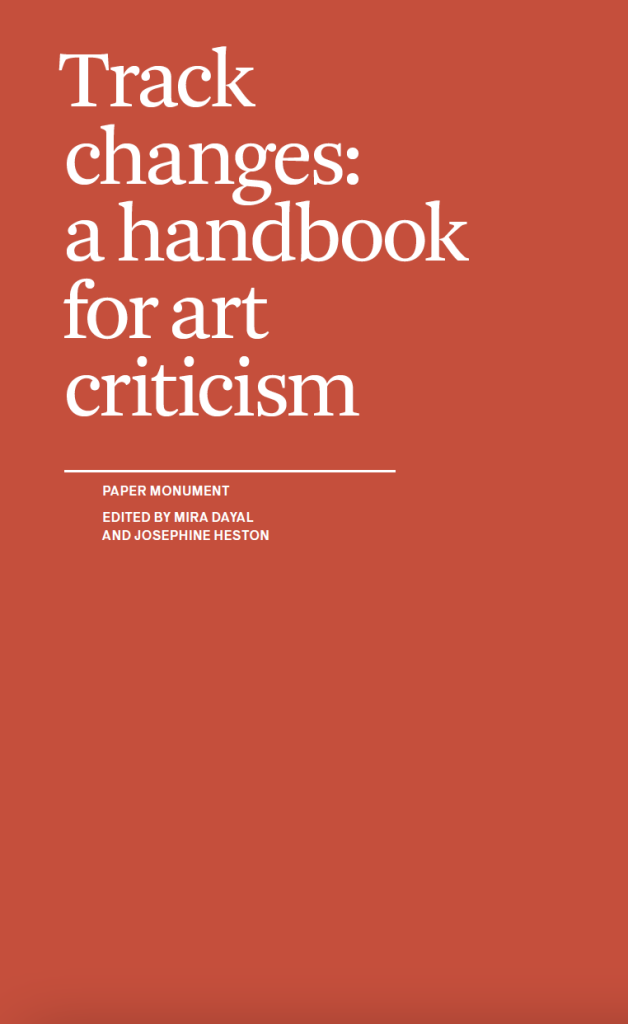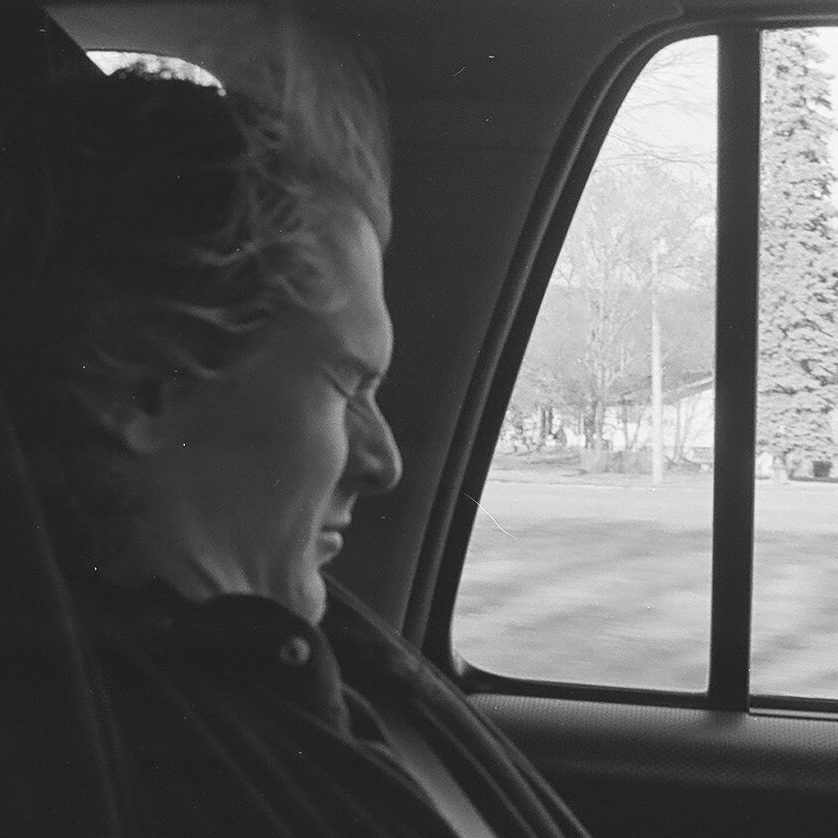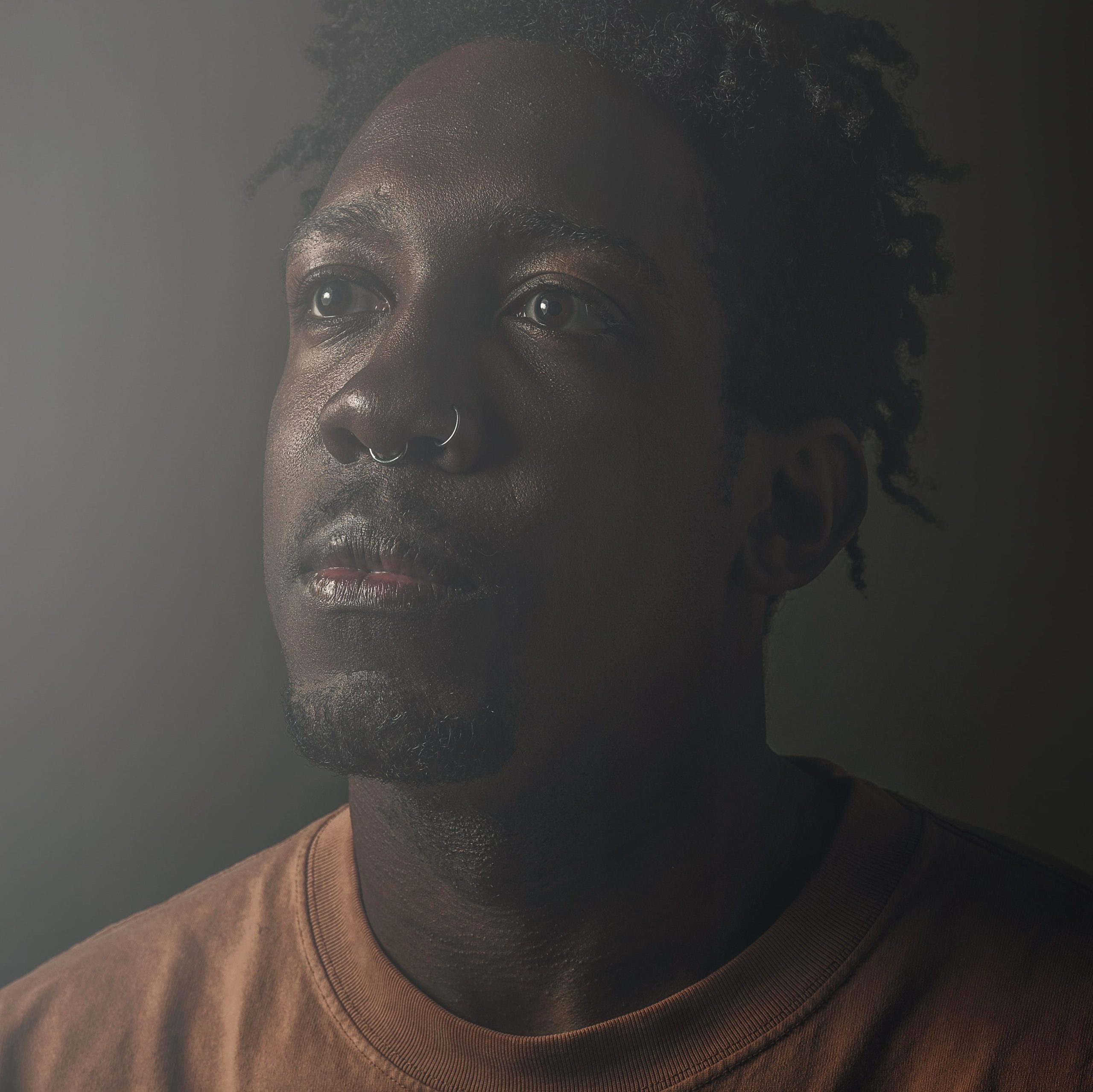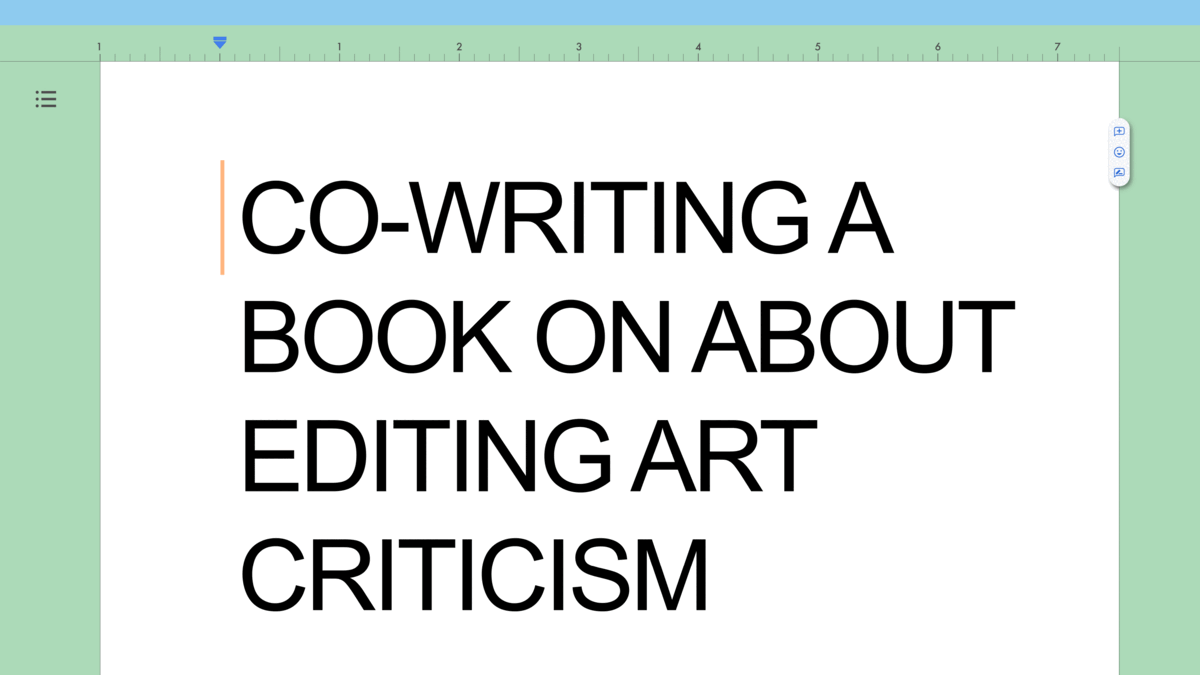“Track changes: a handbook for art criticism” is a collection of case studies, conversations, manifestos, and reflections by twenty-five contributors that dives into technical and ethical choices that writers and editors often face. Arts writer Ian Carstens talked with the editors of the collection, Mira Dayal and Josephine Heston, via email.
This interview has been edited for length and clarity.
Ian Carstens: Let’s start with the title. I’m getting the nod to Microsoft Word, but also notions of animal tracks, printed text as tracks on a page, timelines, climate change, surveillance states, archives, and observation as an act. Could you speak about how this title informs understanding of the texts, and how you see the title signifying what your intentions are?
Mira Dayal: I love these additional associations! Yes, for us, “track changes” encapsulates two aims of the book. It gestures first to the tool in Word that most editors use so that their revisions are clear to a writer. This reference felt important because the book is partly a practical guide to criticism that outlines the nuts and bolts of the editorial process, and it encourages transparency and support among writers and editors.
The phrase also alludes to some central ideas in the book: many of the essays discuss how criticism registers, responds to, and even propels larger societal shifts in, for example, the ways we understand and speak about race, gender, or disability. In that sense—to refer back to your list—criticism is not only a practice of archiving and observing but also a tool for changing a larger cultural climate.
IC: What was the overall process like to make “Track changes”?
MD: In the early stages of the book, while considering which of the many writers and editors we admire to invite into this project, we focused on people who seemed invested in that second idea of tracking and motivating changes through their criticism. With the same spirit as other Paper Monument books, “Track changes” is focused on opening up conversations that usually happen behind the scenes and asking people to reflect on assumptions and dynamics within the art world. We invited people to critique the language or procedures commonly used in art criticism, to articulate different intentions they’ve set for themselves as a writer or editor, to reflect on decisions and changes they’ve made in their practice, and to share strategies for solidarity in publishing.
Josephine Heston: The structure of the book was also intended to break down the process of producing art criticism so we could track how changes can be made at each stage. The book opens with an introduction and a brief practical guide to the editorial process, then continues with the following chapters: “Pitching and Commissioning,” “Writing” (which includes subsections on “Critique and Positions;” “Form, Style, and Voice;” and “Language and Vocabulary”), “Editing and Publishing,” and “Reading and Reflecting.” The intention behind this was to catalog some of the different components that make up art criticism and offer examples of how one might contemplate the choices they’re making in each of those areas.
IC: Did the process change your approach or intentions as it unfolded?
JH: The collaborative commissioning process allowed writers to respond to the topics they were initially inspired by, so the book really ended up being shaped by the themes the contributors were most concerned with at the time of their writing.
IC: And what is it like for two people to be editors on a text like this?
MD: It was very helpful for us to be in dialogue to refine ideas over the course of making the book, from discussing potential contributors to sharing the work of editing. Practically speaking, we split up initial edits of the commissioned essays and top edited each other’s edits to ensure that every piece was thoroughly considered from different perspectives. This made the whole process akin to what happens at a magazine, where editors often work together to brainstorm commissions, shape texts, and devise themes for an issue.
Importantly, the idea for this book emerged from different collaborations—two of the essays in the book about critique were ones that Josie and I discussed with a group at a residency program that we co-organized with Katie Giritlian and beck haberstroh. And the conversations that became the initial material for the book emerged from a curatorial residency I did at the invitation of Janna Dyk at SOHO20, under the umbrella of a program called “Rethinking Feminism.” Those relationships and contexts shaped the early contours of the project.

IC: Could you speak about the strategies and formal choices you employed to create “Track changes?”
MD: We think of this book as a multi-voiced mentor. To emphasize the candid and informal tone of a conversation, we included excerpts of actual discussions I organized with some of the writers and editors in the early stages of this project. To ensure that the book felt like a guide, we structured it according to the stages of the editorial process, so that texts about the commissioning and pitching processes come first, and essays about reflecting on one’s practice or reading other people’s writing come last. We also included a range of voices, from people working in different cities across the United States and Canada, at different career stages, with different interests and concerns.
JH: It was also important that this book serve as a resource, so we found ways to include additional sources for continued research. For example, we asked the contributors to use their bios to share their trajectories and demonstrate the different paths people have taken to establish their careers in art criticism. We additionally asked the contributors to share texts that have informed their practice which we compiled into a further reading section at the end of the book.
IC: Could you expand on why “handbook” was the right term/strategy for this work?
MD: Handbooks are guides to a field. They are thorough and accessible. For our book, we envisioned an audience partly composed of emerging writers and editors who are trying to enter the field of criticism; some of the common questions that students or writers ask me are relatively logistical or procedural, but that information can be hard to find and requires some knowledge of how people communicate internally in publishing. This kind of guidance is usually only gained through individual relationships, jobs, or internships.
We also wanted to support people who are trying to navigate systemic issues within—or work outside of—art institutions. We wanted to learn how those in publishing are already working to enact change in the field of art. We wanted to encourage others to try out those strategies or consider and share their own.
IC: “Track changes” centers transparency, guidance and support. This feels intentionally antithetical to a version of “conventional” art criticism; understood as elitist, objective and white, settler-colonial and patriarchal. I come away from this collection with a sense of criticism as power and respect. Could you speak more to how criticism can exist in an ecosystem of power and respect?
MD: Yes, many of the essays actually argue that art criticism is itself a space of respect, and a tool of power. If we agree that criticism wields power, then it’s important to have more conversations about who’s using this tool and why, and how we can use it better.
IC: Why not include works dealing with the historical context of art criticism?
MD: During the years-long process of making this book, which I started the year before the pandemic, many magazines have restructured, made layoffs, prioritized metrics, and changed how they operate financially. The field of publishing is always undergoing changes, but we have been experiencing all of that at the same time as widespread social unrest and limited systemic changes. At the same time, in the past decade or so, many books and papers have been published about crises in art criticism, but relatively less has been published that compiles models for criticism, offers paths forward, or shares resources for navigating the field.
So in making a book about art criticism now, our interest was really in contemporary approaches, and where to steer the ship from here. Many of the contributors respond to historical approaches to critique and solidarity, and we do include a reading list that incorporates older discussions of criticism, but we wanted to commission new reflections from both emerging and established people working in our present conditions.
IC: What can’t art criticism do?
JH: While I do believe that art criticism can help shift the ways we value and engage with art and artists, I know that alone it cannot change the way the art world is structured to maintain systems of power. That being said, in the past several years, it’s been inspiring to see art critics take a journalistic approach to discussing these issues and I’m hopeful that with increased visibility we’ll be able to find ways to collaborate with workers across different fields to address shared struggles for ethical working conditions.
MD: Art criticism is also largely written and read by a subset of people who are already part of the art world or have some prior interest in or relationship to it. So while artists’ ideas can often ripple out over time into other parts of society, art criticism itself usually has a limited audience. Some of the contributors write about this dilemma, and how it has shaped their objectives as writers.
JH: I also feel it’s important to acknowledge that writing art criticism additionally requires significant financial support, which as it stands in most cases is not sufficient for sustaining a career as a freelance worker today. This is a consequential barrier to many people and has shaped the field we are currently working in. Nurturing new voices requires rethinking how writers are supported and compensated so they can grow in ways that encourage a long and healthy career.
IC: Where does this book belong? Both culturally and perhaps literally?
JH: Reflecting on how this book has come together over the past couple of years, I can see how it may provide some insight into this moment in time where many people are reimagining what a career in the arts can look like.
MD: We’re also excited that people who teach art criticism or critique have already expressed interest in using the book in the classroom—that’s an ideal home for it. As we were editing the book, we of course identified shared ethics and parallel practices, but we also noticed some divergences in contributors’ approaches, and we find that fruitful. It emphasizes that there isn’t one ideal way to write or edit, and that people’s individual experiences shape the ways they publish. It opens up space for a reader to consider their own perspective.
IC: What do you think “Track changes” leaves unresolved? What do you hope results from this text?
JH: The book is intentionally left open-ended in the sense that it doesn’t offer a singular solution for how we can correct all of the problems in criticism because, realistically, it’s entangled with a larger system in the arts that’s going to take a lot of time and effort from people throughout the field to restructure. However, my hope is that the book will encourage readers to reflect on their own role within this ecosystem, what kind of impact they want to have on their community, and how they might want to change the ways they engage with their work. I believe that these kinds of intentional individual shifts can build upon one another to help push us toward a better future.

About the Author: Ian Carstens (he/him) is a writer, filmmaker and curator based in the Midwest. His work explores temporality, non-human aliveness, multiplicity, as well as critiques of the archive, lens-based art forms and cultural institutions. He is the lead curator/filmmaker of Glass Breakfast, an ongoing archival project. He is also an Associate Editor of Ruckus Art Journal and his writings have been published with Burnaway, Sugarcane, and Limestone Post.

About the Illustrator: NotaPlantShop (also known by his muggle name Damiane Nickles) is a painter and illustrator currently working out of Chicago, IL with roots in Brooklyn, NY. What started as a virtual plant shop selling potted plants with unique stories and running grassroots fundraisers for local organizations from his apt has since evolved into a creative practice that is not limited to one medium. From murals and painted ceramics to flat work and activations, Nickles continues to reinvent himself and bring credence to the chosen name NotaPlantShop. Regardless of which medium he works in, the focus is always on using form, color, and additive processes to explore communal memory and build community.



